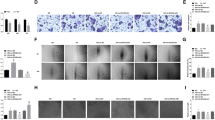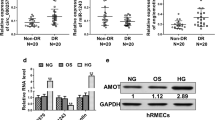Abstract
Diabetic retinopathy (DR) is a serious complication of diabetes mellitus. The purpose of this study was to investigate the potential functional role of long non-coding RNA TUG1 in high glucose (HG)-stimulated human retinal microvascular endothelial cells (hRMECs). The results demonstrated that following 72 h of HG stimulation, enhanced proliferation, migration, and tube formation process were observed in hRMECs. Moreover, HG treatment markedly increased TUG1 expression in hRMECs, and knockdown of TUG1 notably restrained the aberrant phenotypes of hRMECs induced by HG. Mechanistically, TUG1 may serve as a competing endogenous RNA (ceRNA) for miR-145, thereby blocking the repression on VEGF-A in hRMECs. Rescue experiments further indicated that inhibition of miR-145 abolished the beneficial role of TUG1 knockdown in HG-treated hRMECs. Our data suggested that knockdown of TUG1 protects hRMECs against HG stimulation partly by regulating miR-145/VEGF-A axis.




Similar content being viewed by others
References
Simo, R., Carrasco, E., Garcia-Ramirez, M., & Hernandez, C. (2006). Angiogenic and antiangiogenic factors in proliferative diabetic retinopathy. Current Diabetes Reviews, 2(1), 71–98.
Wapinski, O., & Chang, H. Y. (2011). Long noncoding RNAs and human disease. Trends in Cell Biology., 21(6), 354–361.
Young, T. L., Matsuda, T., & Cepko, C. L. (2005). The noncoding RNA taurine upregulated gene 1 is required for differentiation of the murine retina. Current Biology, 15(6), 501–512.
Dong, R., Liu, G. B., Liu, B. H., Chen, G., Li, K., Zheng, S., et al. (2016). Targeting long non-coding RNA-TUG1 inhibits tumor growth and angiogenesis in hepatoblastoma. Cell Death & Disease, 7(6), e2278.
Cai, H., Liu, X., Zheng, J., Xue, Y., Ma, J., Li, Z., et al. (2017). Long non-coding RNA taurine upregulated 1 enhances tumor-induced angiogenesis through inhibiting microRNA-299 in human glioblastoma. Oncogene, 36(3), 318–331.
Gong, Q., Dong, W., Fan, Y., Chen, F., Bian, X., Xu, X., et al. (2019). LncRNA TDRG1-mediated overexpression of VEGF aggravated retinal microvascular endothelial cell dysfunction in diabetic retinopathy. Frontiers in Pharmacology, 10, 1703.
Livak, K. J., & Schmittgen, T. D. (2001). Analysis of relative gene expression data using real-time quantitative PCR and the 2(-Delta Delta C(T)) Method. Methods, 25(4), 402–408.
Gong, Q., & Su, G. (2017). Roles of miRNAs and long noncoding RNAs in the progression of diabetic retinopathy. Bioscience Reports, 37(6), 245.
Yin, L., Sun, Z., Ren, Q., Su, X., & Zhang, D. (2019). Long non-coding RNA BANCR is overexpressed in patients with diabetic retinopathy and promotes apoptosis of retinal pigment epithelial cells. Medical Science Monitor, 25, 2845–2851.
Wei, J. C., Shi, Y. L., & Wang, Q. (2019). LncRNA ANRIL knockdown ameliorates retinopathy in diabetic rats by inhibiting the NF-kappaB pathway. European Review for Medical and Pharmacological Sciences., 23(18), 7732–7739.
Blair, R. J., Meng, H., Marchese, M. J., Ren, S., Schwartz, L. B., Tonnesen, M. G., et al. (1997). Human mast cells stimulate vascular tube formation: Tryptase is a novel, potent angiogenic factor. The Journal of Clinical Investigation, 99(11), 2691–2700.
Martinez, B., & Peplow, P. V. (2019). MicroRNAs as biomarkers of diabetic retinopathy and disease progression. Neural Regeneration Research., 14(11), 1858–1869.
Salmena, L., Poliseno, L., Tay, Y., Kats, L., & Pandolfi, P. P. (2011). A ceRNA hypothesis: The Rosetta Stone of a hidden RNA language? Cell, 146(3), 353–358.
Hui, Y., & Yin, Y. (2018). MicroRNA-145 attenuates high glucose-induced oxidative stress and inflammation in retinal endothelial cells through regulating TLR4/NF-kappaB signaling. Life Sciences, 207, 212–218.
Witmer, A. N., Vrensen, G. F., Van Noorden, C. J., & Schlingemann, R. O. (2003). Vascular endothelial growth factors and angiogenesis in eye disease. Progress in Retinal and Eye Research., 22(1), 1–29.
Zou, C., Xu, Q., Mao, F., Li, D., Bian, C., Liu, L. Z., et al. (2012). MiR-145 inhibits tumor angiogenesis and growth by N-RAS and VEGF. Cell Cycle, 11(11), 2137–2145.
Acknowledgements
This work was supported by Foundation of Wuxi Commission of Health (NO:MS201914) and by the National Natural Science Foundation of China [Grant Number 81970585 (to J.T.)].
Author information
Authors and Affiliations
Corresponding author
Ethics declarations
Conflict of interest
The authors declare that they have no conflict of interest.
Additional information
Publisher's Note
Springer Nature remains neutral with regard to jurisdictional claims in published maps and institutional affiliations.
Rights and permissions
About this article
Cite this article
Shi, Q., Tang, J., Wang, M. et al. Knockdown of Long Non-coding RNA TUG1 Suppresses Migration and Tube Formation in High Glucose-Stimulated Human Retinal Microvascular Endothelial Cells by Sponging miRNA-145. Mol Biotechnol 64, 171–177 (2022). https://doi.org/10.1007/s12033-021-00398-5
Received:
Accepted:
Published:
Issue Date:
DOI: https://doi.org/10.1007/s12033-021-00398-5




